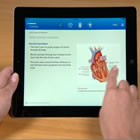|
With the introduction and ongoing refinement of transcatheter aortic valve replacement (TAVR), patients who previously were not eligible for valve replacement can now be treated with percutaneous placement (non-surgical) of an aortic valve. Studies are ongoing for intermediate patients who could be treated surgically, but may prefer the non-surgical method. Moreover, there are a variety of devices on the market; in the U.S. both Edwards (Sapien) and Medtronic (CoreValve) devices are approved by the FDA. But the existence of these options can be confusing for the patient so, when diagnosed with aortic stenosis, it is important that the patient, his/her family and caregiver understand what aortic stenosis is, and how it can be treated. To address this need, Medtronic, manufacturer of both surgical and percutaneous valves, has developed an easy-to-use iPad app, explaining the disease, its treatment options and, importantly, what happens after discharge from the hospital, when the level of care is reduced and additional support becomes very important. Dubbed the "Aortic Stenosis Patient Journey iPad App," nursing staff, as well as patients and their family, can download this tool from the iTunes store for free. The app, developed by Medtronic in collaboration with an advisory board of nurses (valve clinic coordinators) to address the educational needs of this challenging patient population, has received the Seal of Recognition from the Association of periOperative Registered Nurses for meeting the standards of excellence in safe patient care. There are a number of aspects that make patient education for this procedure challenging:
Valve clinic coordinator Susie Page, RN, from the University of Kansas Medical Center in Kansas City, KS, has been using this iPad app and discussed her experience with Angioplasty.Org. Q: In your experience, who uses this app tool most: nursing staff, family or other caregivers, or the patients themselves? Q: Since most patients having this type of procedure are of an advanced age (70+), are they able to use an iPad to view it? Q: What have you seen to be the biggest problems/challenges that SAVR or TAVR patients have, vis-a-vis the procedure and aftercare? And how does this app help in those areas?
What the app does is differentiate between the two. Many people in the populations who receive TAVR know someone, or they themselves, have been through the traditional SAVR. They come in anticipating the same process post TAVR. With the app, we can show the differences and therefore they understand why they will be back to their activities of daily living much, much sooner than the patient undergoing traditional SAVR. Because they have minimal physical wounds from the procedure to recover from, they will immediately start their recovery from their deconditioning that was present before their TAVR that was related to their aortic stenosis, heart failure, etc. They start out way ahead of the game! The bottom line is that this app has become an important tool for me as a TAVR coordinator, not only for patients but for their families and our staff. Below is a short video, supplied and produced by Medtronic, demonstrating the app.
Reported by Burt Cohen, January 25, 2016 |


